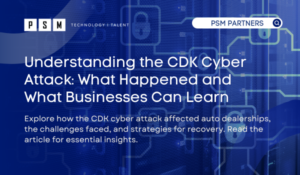Table of Contents
ToggleWhat is an Incident Response Team
When a data breach or cyber-attack occurs, an incident response team is the first line of defense. An incident response team is a group of individuals trained to manage security incidents and breaches. They work rapidly in order to mitigate damage and prevent future incidents from occurring. Incident response teams typically consist of a variety of professionals with a background in information technology, cybersecurity, legal compliance, and crisis management. An incident response team is an essential part of any organization’s disaster preparedness plan. Not only do they play a crucial role in mitigating damage during an emergency event, but they also provide valuable insight for long-term cybersecurity risk management strategies.
What is a Cybersecurity Incident Response Plan
When dealing with a cybersecurity incident, it is important to have a plan in place to manage the situation effectively, this is where an incident response plan comes in. A cybersecurity incident response plan outlines the steps to be taken in the event of a security breach, to ensure that all essential individuals are notified, and that appropriate measures are taken to minimize damage and alleviate ongoing threats. Developing a comprehensive response plan may take time and effort, but it can save time and resources in the event of an incident. By preparing for potential incidents in advance, a clear incident response plan helps to ensure a swift and effective response. Additionally, having a documented response plan in place can demonstrate regulatory compliance and reduce liability issues. Developing and regularly reviewing a robust incident response plan is critical for any organization looking to protect itself from security incidents.
How to create an incident response plan
There are six steps to be taken by the Incident Response Team, in order to successfully control security incidents.
- Preparation: To help protect your network and data against considerable damage, you must replicate and store data in a remote place. Prioritize crucial data backup and note their locations. In addition, you will need to establish a communication plan, document roles, responsibilities, and procedures, and enlist people in your organization to be part of an Incident Response Team (IRT). These steps will help restore your network quickly.
- Identification: This is the step to determine if you have been breached. An incident can originate from separate places. First, determine how severe the incident is. Depending on the type of severity, it determines which groups of people you will relay information to. Then distinguish the individual points of failure in your network and focus on them. Individual points of failure may expose your network when there is an attack. If an authorized employee is unable to respond to an incident, name a second person who can take control of the situation. By having backups in place, your organization can keep incident response and operations under way while limiting damage and disruption to your network.
- Containment: When a breach is first detected, your initial instinct may be to safely remove everything. However, that will harm your business overall since you will be destroying valuable evidence that you will need to identify where the breach started. The next step would be to contain the breach, so it does not continue and cause additional damage to your company. Try to remove corrupted devices from the Internet. It is also good to have a system back-up to help restore operations. This is also a suitable time to update your systems, evaluate your remote access, adjust all user and administrative access credentials, and strengthen all passwords.
- Eradication: The Incident Response Team needs to determine the initial cause of the attack, remove malware, and prevent a similar attack in the future. If there is any indication of malware or security issues that remain in your systems, you might still be losing critical data, and your liability could expand.
- Recovery: The recovery step in your IRP entails restoring and replacing affected systems and devices back into your daily operations. Significant decisions in this stage are taken from which time and date to restore operations and how to determine if the affected systems are back to normal while monitoring activity.
- Lessons Learned: This stage should be implemented no later than two weeks from the end of the incident. The purpose of this stage is to wrap up documentation of the incident, examine the incidents full scope, identify where the response team was effective, and areas that require improvement. In addition, you should be able to define what has worked well in your response plan, and where there were flaws. Lessons learned will help strengthen your systems against future attacks. It is essential that everyone in your organization understands the importance of the plan. After you have created it, educate your staff about incident response. End-to-end employee assistance with an Incident Response Team can minimize the length of disruptions.
Incident Response at PSM
Much of the data stored by businesses and institutions is sensitive and must be protected. Many businesses’ use cloud-based storage, which is more cost-effective than hardware storage, but cloud storage has different vulnerabilities that must be accounted for and secured. Our professionals at PSM can provide cloud security to keep data stored to your cloud safe. With our cloud security managed services, we can help you set up and manage your cloud storage and implement the appropriate security measures to protect from data breaches. Our services monitor and maintain the cloud and make updates when needed to the cloud software and security measures. Effective cloud network security is important for protecting your data from breaches and malware.
PSM offers cloud computing security services to ensure that your data is protected. No matter if you have a public cloud, private cloud, or hybrid cloud solution, we will implement and maintain multi-layer security measures to protect from breaches and prevent access from unauthorized users. Our cloud security measures are customized to your business and determined by your unique retention and recovery requirements.
Related Insights
What is Azure Infrastructure as a Service?
In the increasingly competitive digital age, one-way businesses can stay...
Read MoreNonprofit Cloud Computing: How It Can Transform Operations
Nonprofits face many challenges in their day-to-day operations, including limited...
Read MoreUnderstanding the CDK Cyber Attack: What Happened and What Businesses Can Learn
Key Takeaways From the CDK Global Cyber Attack Massive DisruptionOn...
Read MoreCloud Engineer vs. Software Engineer: Understanding the Differences
In today’s rapidly evolving technology landscape, both cloud and software...
Read MoreAbout the Author

Taylor Friend
I am a dynamic and results-focused Marketing Coordinator at PSM Partners, recognized for my unwavering motivation, meticulous attention to detail, and unwavering commitment to achieving business objectives. Throughout my time at PSM, I have demonstrated remarkable expertise as the primary liaison for Microsoft and NetDocuments, rapidly establishing myself as a proficient point of contact. Additionally, by harnessing my inherent organizational skills, I have effectively elevated the quality of both our internal and external events.





